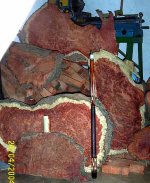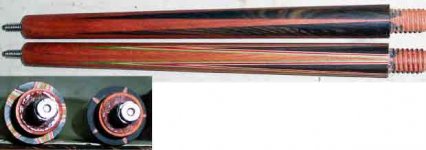You are using an out of date browser. It may not display this or other websites correctly.
You should upgrade or use an alternative browser.
You should upgrade or use an alternative browser.
Bandido's cues
- Thread starter bandido
- Start date
WOW! I have never seen raw unprocessed wood like that before. It is almost a shame that you have to cut it up. Almost.
The 2 slabs with the white sapwood borders will be made into coffee tables for my dad while the rest will be used mostly on cues but that wouldn't be until 2007.Buddha Jones said:WOW! I have never seen raw unprocessed wood like that before. It is almost a shame that you have to cut it up. Almost.
UGH!! Well, I guess that would give me 3 years to save up 
Must be nice to have your own kiln.bandido said:The 2 slabs with the white sapwood borders will be made into coffee tables for my dad while the rest will be used mostly on cues but that wouldn't be until 2007.
Since the wood has been cut into slabs, can we assume it will be used for inlays and/or points?bandido said:The 2 slabs with the white sapwood borders will be made into coffee tables for my dad while the rest will be used mostly on cues but that wouldn't be until 2007.
Also, what other woods, would you match it up with, to make a nice cue.
I'm trying to imagine finished cues, made with this beautiful wood.
Rich R. said:Since the wood has been cut into slabs, can we assume it will be used for inlays and/or points?
Also, what other woods, would you match it up with, to make a nice cue.
I'm trying to imagine finished cues, made with this beautiful wood.
Not really just for points as those slabs are 2 inches thick and the squares are 2x2s.
After this trimming stage I grade them according to workable size, colors and figure. The longest ones are for forearms, full lengths and handles which all gets cored. Once they reach a specified moisture level, they are tapered oversized then dried before hitting the vacuum and pressure assisted stabilizer impregnation tank. Then a couple more months in the humidity and temperature contolled room and they get cored then aged some more.
The next sizes down, butt sleeves and points/inlay slabs goes through the same process except for the coring. Butt sleeve sections get bored undersize and aged before being used. Points/inlay slabs go through the above mentionrd process too.
Amboyna burl is one of the most expensive and rarest of woods so I hardly complicate the inlays that can detract the viewers attention from the beauty of the wood. As a major component, ie. forearm, exposed wood handle or butt sleeve, I minimize the size of the inlays or use light colored inlays as these would then showcase the intricacy and meticulous work done on the inlays.
I always bulk purchase my materials as it's the only way that I find that will allow me to choose the pieces that I want to use.
Last edited:
Ed, would there be any advantage to stabilizing burls?
Joseph Cues said:Ed, would there be any advantage to stabilizing burls?
I prefer to be told that it's an overkill. It doesn't cause it any harm anyway.
Thanks for the information Ed.
One more question, if I may.
When using these burls for forarms and full length handles, do you have to be concerned, in any way, about the direction of the grain, or does the act of coring, make that unnecessary?
Or, because they are burls, is there no definite grain direction to deal with?
One more question, if I may.
When using these burls for forarms and full length handles, do you have to be concerned, in any way, about the direction of the grain, or does the act of coring, make that unnecessary?
Or, because they are burls, is there no definite grain direction to deal with?
Rich R. said:Thanks for the information Ed.
One more question, if I may.
When using these burls for forarms and full length handles, do you have to be concerned, in any way, about the direction of the grain, or does the act of coring, make that unnecessary?
Or, because they are burls, is there no definite grain direction to deal with?
Burls are out-growths of trees and caused by foreign substance invading the trees fibers. The tree's natural defenses in it's system try to isolate these foreign substance by encapsulating.
But even though there is no definite grain direction, I still try not to show a cross-cut for the face. I prefer to configure where I'll get optimal structural strength. Wood has different rates for its tangential, radial and longitudinal shrinkage. "If" shrinkage happen, a cross-cut face will show it the most as the longitudinal shrinkage has the highest rate.
You're welcome Rich but it was my pleasure to answer questions specially coming from an informed and knowledgeable person like you. IMO, design is the immediate evidence that differentiates CMs from one another but structural systems is what is important and really sets them apart from one another. I feel that I still can learn a lot more from people within and outside the industry.Rich R. said:Thanks again for the reply Ed.
I'm glad you mentioned structual strenghth, as that is exactly what I was curious about.
Thanks.
Ed, would you think using burls ( the softer variety) as points on v-pointed cues a bad idea?
I consider soft woods like Holly bad woods for v-pointed cues as they dull the reasonance of the forearm imo.
Flat bottom points are different matter of course as they do not go as deep and do not penetrate the cores ( if the forearm is cored).
I consider soft woods like Holly bad woods for v-pointed cues as they dull the reasonance of the forearm imo.
Flat bottom points are different matter of course as they do not go as deep and do not penetrate the cores ( if the forearm is cored).
Joseph Cues said:Ed, would you think using burls ( the softer variety) as points on v-pointed cues a bad idea?
I consider soft woods like Holly bad woods for v-pointed cues as they dull the reasonance of the forearm imo.
Flat bottom points are different matter of course as they do not go as deep and do not penetrate the cores ( if the forearm is cored).
I have come across some amboyna that are soft and that is the reason why I prefer to buy in bulk . It gives me the freedom to choose the sections that I will use. I do prefer using the burls closest to the main structure of the tree.
I personally don't like using the soft variety but am in the process of investigating through experimentation the advantages of mixing them with the hardwoods. Some CMs do mix sections of softwood with the hardwoods in laminated sections so they can tone down the pinginess of a high density hardwood and as I've said, I'm still checking this out.
After 12 years, V-spliced points revisited. I just finished putting together equipment and a new system for myself on putting together v-spliced points. The centering mandrels are still shown protruding out of the forearm/handle tenon.
These are 5 pointers and the multi-veneered (bottom on top picture and left on the bottom picture) has two 0.9mm and two 0.23 mm veneers. These are the first two products of my new v-splicing system.
These are 5 pointers and the multi-veneered (bottom on top picture and left on the bottom picture) has two 0.9mm and two 0.23 mm veneers. These are the first two products of my new v-splicing system.
Attachments
Hooowowwwwww!!!!!!!!!!bandido said:After 12 years, V-spliced points revisited. I just finished putting together equipment and a new system for myself on putting together v-spliced points. The centering mandrels are still shown protruding out of the forearm/handle tenon.
These are 5 pointers and the multi-veneered (bottom on top picture and left on the bottom picture) has two 0.9mm and two 0.23 mm veneers. These are the first two products of my new v-splicing system.
I think I see phenolic sleeve under clamping on the point stock.
Ed, a closeup of the top of the points where the veneers end would be nice.
I'm emailing this to my friend to see if he wants to get the first ones you make.
You're showing some secrets here Ed. Might wanna edit the pics a little.
Last edited:
V
((VH))
Guest
Nice pics! Any additional inlay work for the two?
How about a close-up shot of the rear where threads are?
I see the pins are there, what joint do you have in mind there? Or is it just that?
How about a close-up shot of the rear where threads are?
I see the pins are there, what joint do you have in mind there? Or is it just that?
Hmm, that one's proprietary I think.((VH)) said:Nice pics! Any additional inlay work for the two?
How about a close-up shot of the rear where threads are?
I see the pins are there, what joint do you have in mind there? Or is it just that?
V
((VH))
Guest
Joseph Cues said:Hmm, that one's proprietary I think.
well if Bandido would oblige it's up to him.
Btw Joseph, meeting up with Blud?

